Supermarine Seafire
Mk.IIc & Mk. III
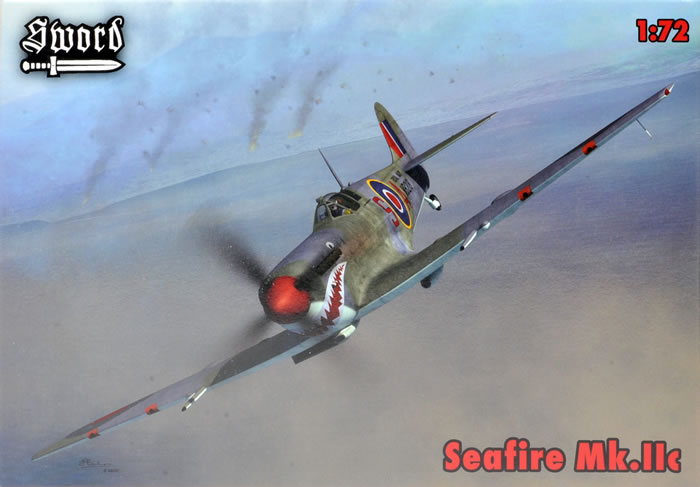
Sword, 1/72 scale
S u m m a r y : |
Catalogue Number: |
SW72083 Supermarine Seafire Mk.IIc
SW72084 Supermarine Seafire Mk.III |
Scale: |
1/72 |
Contents & Media: |
Version |
Grey Styrene Parts |
Clear Styrene Parts |
Resin Parts |
Decal Options |
Mk.IIc |
48 |
3 |
6 |
2 |
Mk.III |
50 |
3 |
6 |
2 |
Price: |
Available from these on-line stockists: |
Kit |
Hannants |
Squadron |
Modelimex |
West Coast Hobbys |
HLJ |
Mk.IIc |
£10.83 |
US$29.24 |
€14.46 |
Can$21.00 |
¥2,250 |
Mk.III |
£10.83 |
US$29.24 |
€14.46 |
Can$21.00 |
¥2,250 |
Click here for currency conversion. |
Review Type: |
First Look. |
Advantages: |
Accurate lines, fine surface detail, good cockpit detail, clear canopy, clean and crisp moulding for a limited run tooling. |
Disadvantages: |
None observed. |
Conclusion: |
These kits conform almost precisely in outline to CMR’s Seafire kits which I like to use as a benchmark for 1/72 Seafire accuracy, and so I think that they are very good in terms of shape and dimensional accuracy.
The moulding of the kits is very clean and crisp for a limited run product, and rate as some of the better examples I have seen in this regard. Cockpit detail is also very good for an injected kit, requiring only seatbelts to finish for a closed canopy model at least. The inclusion of resin cannons in these re-issued kits may be a benefit that offsets halving the decal options when compared to previous releases; although after some thought, I am neutral on this point.
These re-released Seafire kits by Sword are not only the best injected kits of these marks in this scale I have seen, but equal CMR’s in all the ways that matter (but with fewer decal options), with the advantage of injected kit pricing. It should come as no surprise then that recommend them highly. |
Reviewed by
Mark Davies

Sword's 1/72 Seafire Mk.IIc and Mk.III are available online from Squadron.com
The Admiralty first floated the idea of a “Sea Spitfire” in mid-1938, and raised the matter again in late 1939, but RAF priorities were such that the request remained unfulfilled. It was not until late in 1941 that the first hooked Spitfire undertook carrier trials and these continued into early 1942.
The first navalised Spitfires, now called Seafires, were conversions of in-service Spitfire Vb’s. They had an A-frame arrester hook fitted with localised strengthening to absorb the extra loads imparted by shipboard landings, incorporated slinging points in the fuselage sides, and naval avionics replaced the RAF equipment. Deliveries of this first version, known as the Seafire Mk.Ib and powered by either Merlin 45 or 46 engines, commenced in mid-1942. From the 49th conversion onwards, Mk.Ib’s incorporated the same fuselage strengthening as used by the Mk.IIc described below. This no doubt stemmed from the development and conversion or production of the two marks being more or less concurrent, and the fact that failures of arrester hooks on some early Mk.Ib’s showed that greater strength was required than first thought.
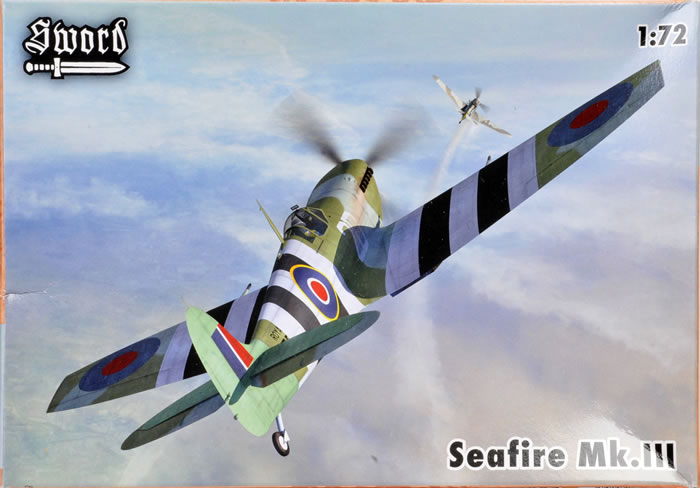
Based on the Spitfire Mk.Vc, the Seafire Mk.IIc was the first production-line version rather than a conversion of in-service aircraft. Those produced by Supermarine’s factory initially utilised unfinished Spitfire Mk.Vc’s already on the assembly line, whereas all of those built by Westland started assembly as Seafires from the outset.
The Seafire Mk.IIc incorporated several changes from the first Mk.Ib’s. It had significant external strengthening added around the arrester hook mounting points, reinforcement around the radio hatch, external fishplates added to the mid-fuselage longerons, launch spools under the wings and various internal strengthening of the structure. Forty thousand man-hours were devoted to these design changes, but even so, there was an unavoidable growth in weight. This required a beefing up of the undercarriage legs that also had their forward raked increased by 2” to reduce the risk of nosing over. The Mk.IIc retained the Merlin 45, 46 engines of the Mk.Ib, but introduced the more powerful Merlin 32 engine for low-level fighter and reconnaissance use in conjunction with clipped wings. The Mk.IIc also adopted a four-blade propeller regardless of the engine version used.

Despite a preference for four cannon made possible by the C-wing, the Admiralty accepted that the weight penalty was too much for an aircraft already heavier than the Spitfire Vc. Therefore, the Seafire Mk.IIc had the same firepower as the Mk.Ib, although it could also carry a single 250-lb bomb on its centreline. The first production Seafire Mk.IIc flew in late-May 1942, yet Westland production did not get into its stride until late 1942.
The Seafire Mk.III was the first variant to have folding wings (Westland also produced 30 Hybrid Mk.III’s without folding wings at the end of Mk.IIc production). Folding wings were a huge benefit for stowage aboard ship as they reduced the span by 23’ 4”. The downside was that having folds also reduced the torsional stiffness of the wing by 10% and added 125-lbs of weight. The Mk.III was otherwise generally similar in appearance to the Mk.IIc. It used either the Merlin 55 or 55M engines that were similar to the Merlin 45/46 but offered barometrically controlled boost to reduce pilot workload. The more powerful Merlin 32 continued to for used the low-level fighter and reconnaissance roles. The Mk.III also introduced the ability to use centreline fuel tanks and could carry a single centreline 500-lb bomb, or alternately two 250-lb bombs or six 60-lb rocket projectiles under its wings.
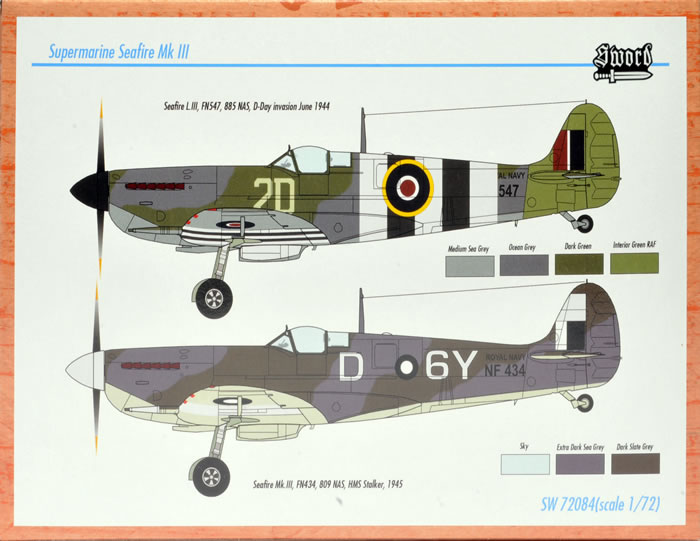
The Seafire Mk.III served until a short time after the end of WW2, as well as serving post-war with the French Aeronavale and the Irish Air Corps. Griffon-engined Seafires had already begun to replace the Mk.III within the FAA just before the war’s end, and would do so later with the Aeronavale as well.
Contents
The kits reviewed here are re-issues of releases made by Sword in 2012; the Seafire Mk.IIc’s previous stock number being SW72040, and the Mk.III’s SW 72055. They remain nicely moulded and detailed limited-run kits with clear styrene canopies. They include a modest amount of resin, but no PE parts. The end-opening boxes have digitally created artwork on the front with colour profiles of the decal schemes offered on the rear.
The folded A-4 sized instructions contain a parts map and diagrammatic assembly stages as you would expect. The instructions have well-drawn and clear diagrams, but the parts map does not list all resin parts, and fails to cross off many surplus Spitfire Mk V parts (making an accurate parts count tricky for reviewers!). Paint call-outs use either generic or British military colour names, and do not refer to recognized paint systems or model paint ranges. Written instructions are in English and Czech, and used sparingly.
A zip-lock plastic bag contains all of the kit components and instructions, with the canopy further protected by its own zip-lock bag; the resin parts being loose within the main bag. The parts are typically limited run in that they lack locating lugs, and the mould engineering avoids deep draws. The canopies look thin and clear, and the decals appear well printed.
Unsurprisingly, the kits share some parts with Sword’s Spitfire Mk.Vc kit. Unlike their earlier Seafire IIc & III boxings, the surplus Spitfire fuselages, and in the case of the Seafire III, the wings also, remain on the sprues. So Sword’s labour-saving benefits the spares box with these and several other parts such as propellers and exhausts. These two new boxings also feature resin cannon barrels and blanking-domes unlike the earlier boxing styrene cannons, which are still on the sprues. In fact, four resin cannon are provided, but only two were fitted to these early marks of Seafire. The trade off for having resin parts seems to be limiting the kits to two decal options in each case, versus the earlier boxings’ four.
I normally believe in buying early following a new limited run kit’s release, as their moulds can become tired and sometimes damaged as production runs take their toll on them. However, I compared this latest Seafire III (SW72084) release to my remaining copy of the earlier boxing (SW72055) and could not see any readily noticeable difference in quality between them. The kit parts should need only a little more cleaning prep than their mainstream brand equivalents, and maybe some fit adjustment, but that is about it.
The Airframe
Surface detail is very good with delicate recessed panel lines that are uninterrupted and of a consistent depth, unlike some short run kits that need re-scribing in places.
The cockpits have sidewall detail moulded inside the fuselage halves, a rear frame with separate seat armour, headrest, and a solid floor that simulates the real plane’s open structure along with rudder actuator rods and pedals. The instrument panel looks good complete with its compass repeater. The seat is good, but there is no harness. There is a voltage regulator to go behind the headrest. A good control column, oxygen bottles, and a nice gun-sight complete the cockpit (two styles are included but only one is applicable). The one-piece canopy is thin and clear with a small mirror to mount on the windscreen.
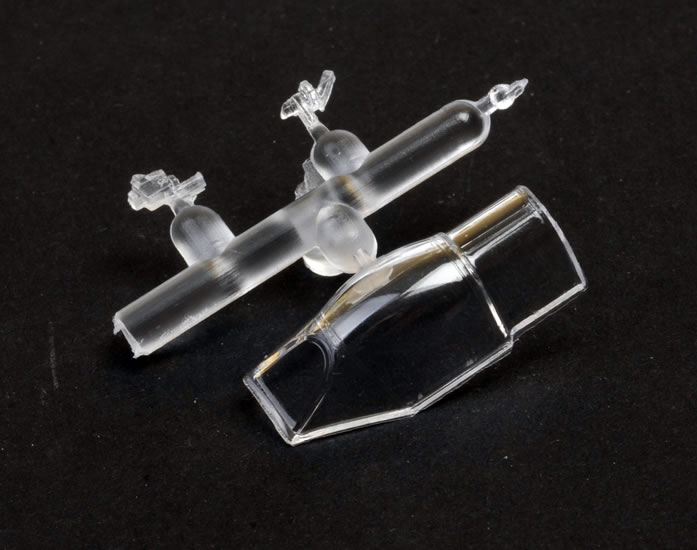
Airframe construction for both marks is conventional and the same. The trailing edges of wings are commendably fine. The radiator housings have separate matrix faces and the underside of the wing has the correctly shaped trough to allow for the full depth of these. The elevators and rudders have nicely represented fabric areas.
The fuselages all differ from a Spitfire’s as they should; with fish-plate longerons running along the mid-fuselage, catapult spools and reinforcing to the lower mid-rear fuselage, and strengthening around the radio hatch. The A-frame arrester hook arrangement is catered for with two parts, one being the fuselage insert and the other the combined hinged section of fuselage and hook. These parts fit into a slot within the fuselage halves, and enable you to position the hook dropped if desired. The Seafire III’s wings include the fold lines. Both kits have a clipped wing option that requires the regular tips to be cut off and replaced with the clipped version’s fairings.
The simple and small main wheel wells have their sides boxed in where the leg retracts by two separate straight parts, whilst curved pieces moulded integrally with the lower wing partially enclose the circular wheel opening, the remaining open portion of which is closed off by a separate flat section part. The undercarriage legs should be fitted with 2 degrees more rake than would a Spitfire’s. The legs, doors and wheels all appear fine.
The cannons and the blanking domes can be a weak point with injected Seafire and Spitfire kits. The Mk.III’s cannons are better than might expected in a limited run kit, and cleaned up they should be most acceptable. However, taking a leaf from their Seafire Mk.XV & XVII kits, Sword have included very good resin cannons for some reason, and so avoid the potential problem altogether. The “price” as mentioned earlier, seems to be a halving of the deal options supplied .
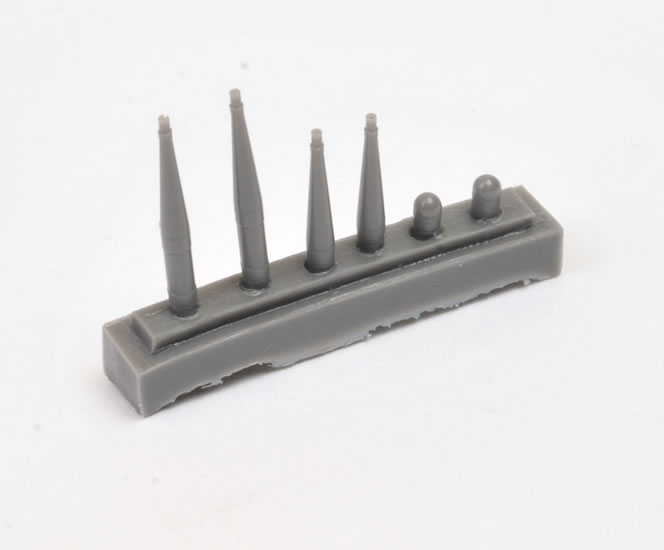
The props and spinners look the part, with the blades having quite reasonable shape and adequate chord. A pair of resin exhausts replaces the styrene examples also supplied, but these are not mentioned on the parts map. These fit into a recess created by cementing backing boxes inside then fuselage halves. An under-wing pitot and antenna mast complete the assembly. The Mk.III could carry a bombs or rockets, but none are provided.
Marking Options
The painting and markings guide for each kit consists of black & white shaded four-view drawings within the instructions, with each scheme supported by a single colour profile on the reverse face of the kit box. Colour call-outs use British military colour names only. The decals, printed by Techmod, look to be good quality with sharp registration. I can report that I have found Sword’s decals to be very good when I have used them previously. There is sheet of stencils and walkway lines common to each kit but printed within the kit’s own decal sheet. A small four-view guide in the instructions details the stencil locations.
The markings options provided by each kit are as follows:
Seafire Mk.IIc
- MB 218, 809 NAS, Operation Avalanche, HMS Unicorn 1943; and
- MB 156, 880 NAS, Operation Torch, HMS Argus 1942.
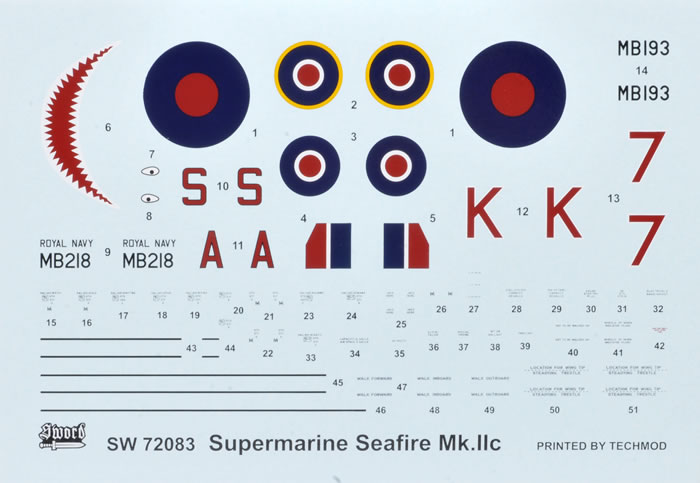
Seafire Mk.III
- NF 547, 885 NAS, D-Day invasion June 1944; and
- NF 434, 809 NAS, HMS Stalker 1945.
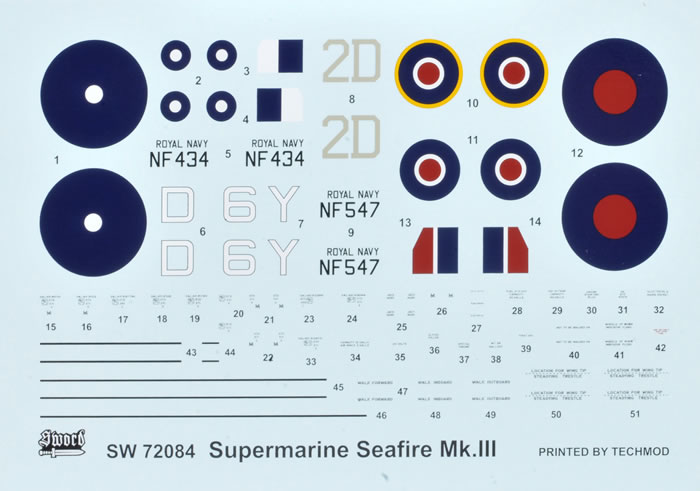
Accuracy & Comparisons
I have previously compared Sword’s Seafire kits to other brand Seafires, including those I consider are the best 1/72 examples available; these being resin kits by CMR. I already regard the Sword kits as superior and better value than alternative Seafire Mk.IIc or III kits by both Highplanes and Pavla, so shall restrict my comments here to comparison with the CMR kits.
The comparison showed that the flying surfaces are essentially the same in outline for both brands. A quick (and a little rough & ready) measurement of unassembled parts shows all marks of both brands scale out to be either spot on or within about a millimetre of published dimensions, meaning they are within a scale 3 inches of where they should be. The Sword fuselages for all marks are about 1-mm longer than the CMR equivalents, and this extra length seems to lie in the rear fuselage. CMR’s overall lengths proved closer to the published dimensions. However, overall linear measurements do not give a true picture when proportionality is considered. The comparison seems too close in my opinion to draw any definitive conclusions, other than to say that I think both brands stack up very well for shape and scale, and are almost indistinguishable in this regard.
So, in my view Sword’s Seafire kits are very good in terms of shape and accuracy because they correspond so well to CMR’s lines. The Sword kits need a bit more assembly effort because they have quite a few more parts compared to the CMR kits, but few will complain about this. Given their price advantage over CMR’s resin Seafires, and the familiarity most modellers have with injected kits, this comparison must weigh heavily in Sword’s favour.
These kits conform almost precisely in outline to CMR’s Seafire kits which I like to use as a benchmark for 1/72 Seafire accuracy, and so I think that they are very good in terms of shape and dimensional accuracy.
The moulding of the kits is very clean and crisp for a limited run product, and rate as some of the better examples I have seen in this regard. Cockpit detail is also very good for an injected kit, requiring only seatbelts to finish for a closed canopy model at least. The inclusion of resin cannons in these re-issued kits may be a benefit that offsets halving the decal options when compared to previous releases; although after some thought, I am neutral on this point.
These re-released Seafire kits by Sword are not only the best injected kits of these marks in this scale I have seen, but equal CMR’s in all the ways that matter (but with fewer decal options), with the advantage of injected kit pricing. It should come as no surprise then that recommend them highly.
Thanks to Sword Models and Hannants for this review sample.
Review Text Copyright © 2014 by Mark Davies
Review Images Copyright © 2014 by Brett Green
Page Created 25 November, 2014
Last updated
25 November, 2014
Back to HyperScale Main Page

|
